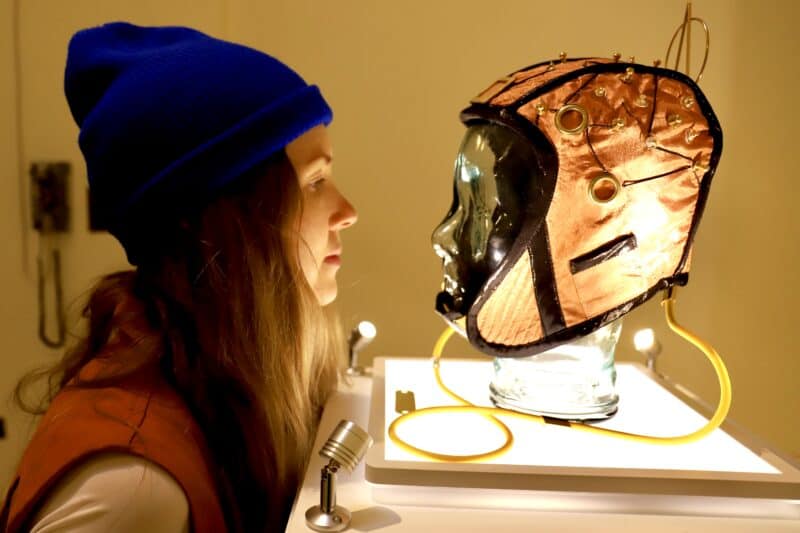
Zachary Lieberman
Cooper Hewitt, Smithsonian Design Museum (New York) will once again represent the United States at the London Design Biennale with “Face Values,” an immersive installation that explores the pervasive yet often hidden role of facial detection technology in contemporary society. The exhibition is curated by Ellen Lupton, senior curator of contemporary design at Cooper Hewitt, and features original work by designers Zachary Lieberman and R. Luke DuBois displayed within a digital environment designed by Matter Architecture Practice.

Matter exhibition Render
Responding to the Biennale’s theme of “Emotional States,” “Face Values” investigates how the human face has become a living data source that governments and businesses use to track, measure and monetize emotions. Using their own faces to control cameras and software, viewers will experience the power and limitations of emotion recognition technologies. Playful and provocative interactions with the work will allow viewers to gain further awareness of how these tools are incorporated into countless products and systems, in ways that the public may not fully realize. “Face Values” speaks to the growing fascination around facial recognition technology, particularly in the U.S. where major companies continue to experiment and push boundaries with this controversial software.
Caroline Baumann, director of Cooper Hewitt, notes,
“In representing the United States at the London Design Biennale, Cooper Hewitt will be furthering the Smithsonian’s goal of catalyzing new conversations around issues of global importance while underscoring design’s purpose to address complex challenges and advance empowering solutions. Illuminating the potential of facial recognition technology to quantify, read and control our moods and movements, ‘Face Values’ encourages participants to consider the vast capabilities and unforeseen consequences of this rapidly evolving field of digital design.”
Lieberman and DuBois’ installations directly engage the viewer in a public performance of emotion to demonstrate how machine-learning technologies evaluate people’s behaviours and assess their identities. Each piece produces new composite portraits of viewers based on how the system reads their facial features and emotions. In Lieberman’s piece, the new portrait is created by mixing the viewer’s face with expressions generated by other visitors, while in DuBois’ work a computer instructs viewers in a commanding voice to enact a series of different emotions toward the screen. The system then creates the new portrait based on an average of these reactions and calculates each visitor’s identity and emotional state. A garden of synthetic three-dimensional reeds designed by Matter Architecture Practice serve as the backdrop for Lieberman and DuBois’ installations, evoking a strange marriage of nature and technology. The exhibition will be supported by designer and historian Jessica Helfand’s visual essay, which explains how scientists, criminologists and beauty experts have tried to quantify the human face.
“Across history, artists, designers and scientists have sought to codify facial features and emotional states,”
Lupton said.
“It is only in our present time, however, that the products that we use can now read our emotions and develop their own perceptions of who we are. In bringing together these works of design, architecture and scholarship, ‘Face Values’ allows us to view today’s technologies in relation to a broader cultural and scientific history, as well as expand our understanding of how technology and design are forever changing both our digital and physical lives.”
Face Values USA Pavilion at London Design Biennale 2018, Somerset House
4 – 23 September 2018 londondesignbiennale.com
ABOUT THE DESIGNERS
DuBois explores temporal, verbal and visual structures through music, art and technology. He is the director of the Brooklyn Experimental Media Center at the NYU Tandon School of Engineering, where he and his students explore the implications of new technologies for individuals and society. His work expands the limits of portraiture in the digital age by linking human identity to data and social networks.
Lieberman uses technology to augment the body’s ability to communicate. He is the creator of openFrameworks, a tool for creative coding, and he is the founder of the School for Poetic Computation in Brooklyn. EyeWriter, an eye-tracking interface designed for people with paralysis, won Design of the Year (Interactive) 2010 from the London Design Museum. Lieberman’s work actively explores the human face as a controller and interface for software.
Matter Architecture Practice is co-directed by Sandra Wheeler and Alfred Zollinger. Matter has received top honors for its work in exhibition design, which seeks to tell complex stories about data and society through engaging, physically rich environments. Matter was a finalist of the PS1/MoMA Young Architects Program and the winner of AIA New Practices New York, a juried selection recognizing up-and-coming, innovative firms in the city.
ABOUT COOPER HEWITT
Founded in 1897, Cooper Hewitt is the only museum in the United States devoted exclusively to historic and contemporary design. Cooper Hewitt is America’s design museum. Inclusive, innovative, and experimental, the museum’s dynamic exhibitions, education programs, master’s program, publications, and online resources inspire, educate, and empower people through design. An integral part of the Smithsonian Institution—the world’s largest museum and research complex—Cooper Hewitt is located on New York City’s Museum Mile in the historic, landmark Carnegie Mansion. Steward of one of the world’s most diverse and comprehensive design collections—over 210,000 objects that range from an ancient Egyptian faience cup dating to about 1100 BCE to contemporary 3D-printed objects and digital code—Cooper Hewitt welcomes everyone to discover the importance of design and its power to change the world. cooperhewitt.org







